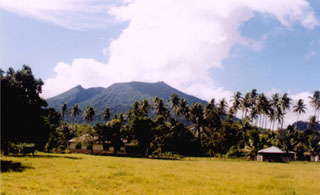Report on Ibu (Indonesia) — 25 December-31 December 2024
Smithsonian Institution / US Geological Survey
Weekly Volcanic Activity Report, 25 December-31 December 2024
Managing Editor: Sally Sennert.
Please cite this report as:
Global Volcanism Program, 2024. Report on Ibu (Indonesia) (Sennert, S, ed.). Weekly Volcanic Activity Report, 25 December-31 December 2024. Smithsonian Institution and US Geological Survey.
Ibu
Indonesia
1.488°N, 127.63°E; summit elev. 1325 m
All times are local (unless otherwise noted)
The Pusat Vulkanologi dan Mitigasi Bencana Geologi (PVMBG) reported that the eruption at Ibu continued during 18-31 December. Daily gray or white-and-gray ash plumes that were often dense generally rose 100-800 m above the summit and drifted in multiple directions. On occasion dense plumes rose higher: at 0600 on 19 December an ash plume rose 1.5 km above the crater and drifted E; at 2310 on 20 December an ash plume rose 2.5 km above the crater rim and drifted NE; at 1711 and 1835 on 22 December ash plumes rose 1.2 and 2.5 km above the crater rim, respectively, and drifted NE and E; at 1032 on 24 December an ash plume rose 2 km above the crater rim and drifted SE and E; at 1258 on 25 December an ash plume rose 1.5 km above the crater rim and drifted SE; and at 2105 on 29 December and at 0518 on 31 December ash plumes rose 3 km above the crater rim and drifted NE, E and SE. Webcam images posted with some of the reports showed incandescence at the summit or being ejected above the summit of the inner active cone. The Alert Level remained at 3 (the second highest level on a four-level scale) and the public was advised to stay 4 km away from the active crater and 5.5 km away from the N crater wall opening.
Geological Summary. The truncated summit of Gunung Ibu stratovolcano along the NW coast of Halmahera Island has large nested summit craters. The inner crater, 1 km wide and 400 m deep, has contained several small crater lakes. The 1.2-km-wide outer crater is breached on the N, creating a steep-walled valley. A large cone grew ENE of the summit, and a smaller one to the WSW has fed a lava flow down the W flank. A group of maars is located below the N and W flanks. The first observed and recorded eruption was a small explosion from the summit crater in 1911. Eruptive activity began again in December 1998, producing a lava dome that eventually covered much of the floor of the inner summit crater along with ongoing explosive ash emissions.
Source: Pusat Vulkanologi dan Mitigasi Bencana Geologi (PVMBG, also known as CVGHM)

